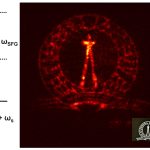Air gusts or currents in the wake of a fast-moving object like a car or truck is a common phenomenon that many among us have experienced. In such ‘wake flows’, air typically moves around in an unsteady and whirling manner. This motion of air presents very interesting patterns in space, with a certain associated periodicity in time.
Premika S Thasu and Duvvuri Subrahmanyam from the Department of Aerospace Engineering attempted to answer the following question: What do wake patterns for an object that is moving at a very high speed look like? They experimentally studied the wake generated by a simple object — a circular cylinder — moving at Mach 6 (six times the speed of sound).
The wake flow was found to have a strong characteristic frequency, and interestingly, the frequency exhibited ‘universal scaling’. This means that once the frequency for a given cylinder size and flow speed is known (measured), the frequency for any cylinder of a different size and/or moving at a different speed can be readily predicted. The researchers were therefore able to obtain new fundamental insights into the physical mechanisms that give rise to the characteristic frequency by analysing the wake flow patterns.






